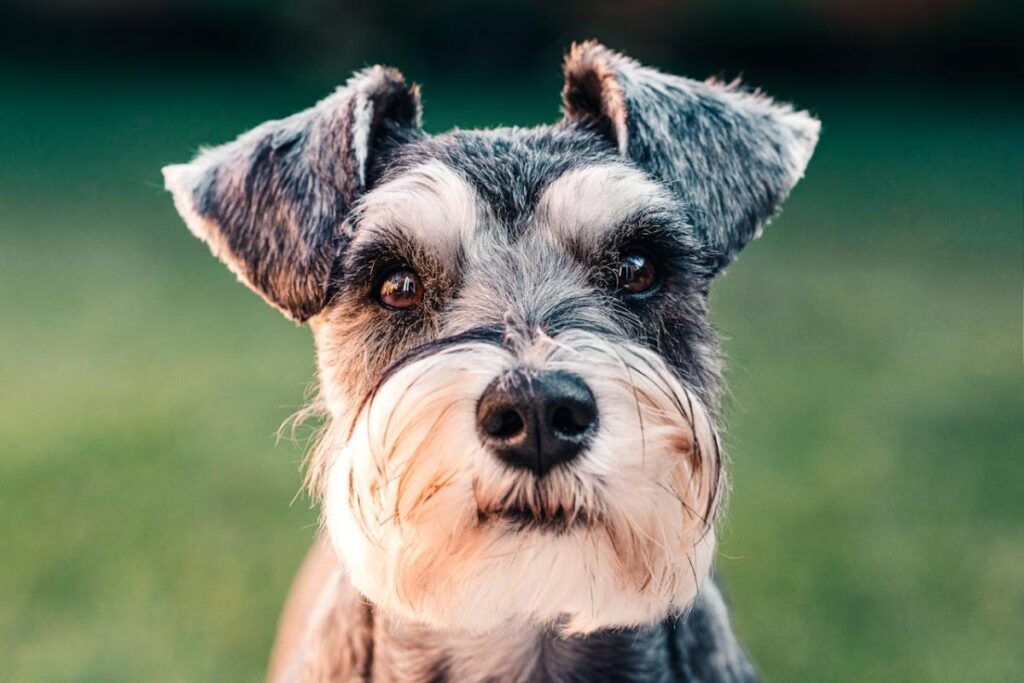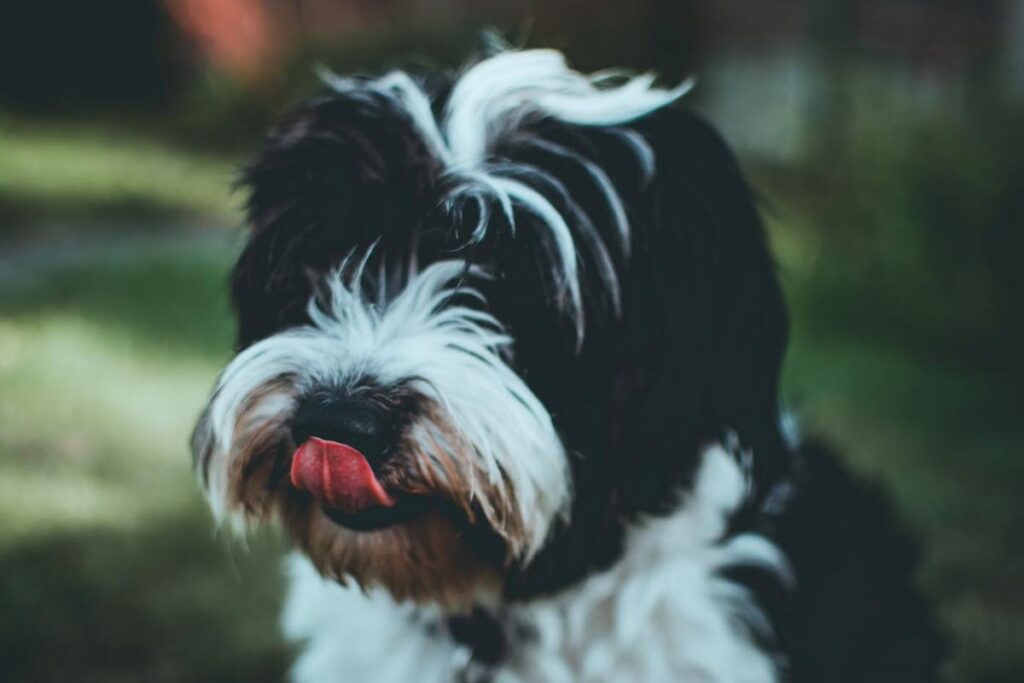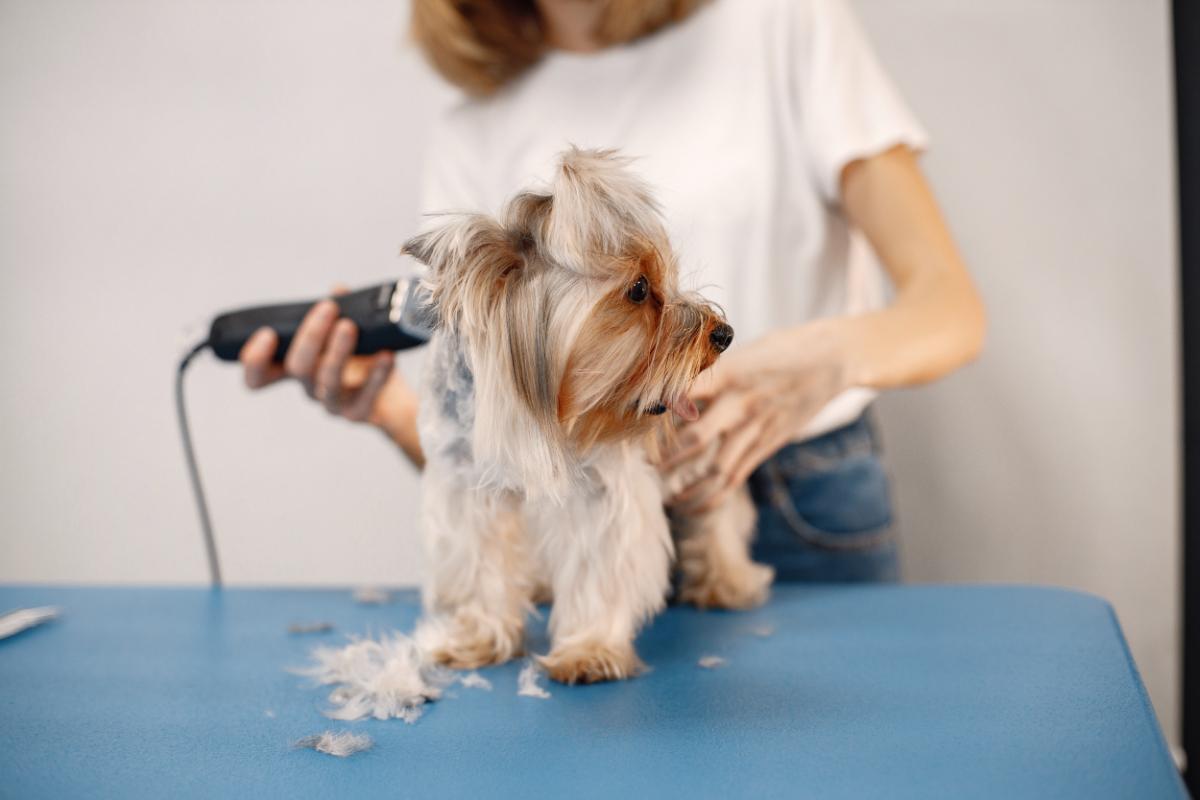Yes, you can shave your Schnauzer, but you should seriously consider the potential risks before doing so.
Shaving might damage their coat and skin since Schnauzers have a double coat that protects them from various weather conditions and helps regulate their body temperature.
Shaving can also lead to uneven regrowth and make their coat harder to manage, increasing the risk of skin problems and potential infections.
If your Schnauzer has severe matting or a specific skin condition, consult a professional groomer or vet first.
Shaving should be a last resort. Curious about grooming alternatives? More insight awaits just ahead.
Can Schnauzers Be Shaved
Jump to a Specific Section
- 1 Key Takeaways.
- 2 Understanding Schnauzer Coats
- 3 Risks of Shaving Schnauzers
- 4 Grooming Alternatives to Shaving
- 5 When Shaving May Be Necessary
- 6 Can Schnauzers be Shaved? How to Trim a Schnauzer’s Coat
- 7 Maintaining Coat Health Post-Shave
- 8 Professional Grooming Techniques
- 9 Preparing for a Grooming Session
- 10 Aftercare for Groomed Schnauzers
- 11 Choosing the Right Grooming Tools
- 12 Frequently Asked Questions:
- 13 How Do I Cut My Mini Schnauzer Hair?
- 14 Will My Schnauzers Hair Grow Back?
- 15 Should You Shave a Giant Schnauzer?
- 16 What Does a Schnauzer Cut Look Like?
- 17 Conclusion
Key Takeaways.
- Schnauzers should not be shaved as it can damage their protective double coat and alter their texture.
- Shaving may lead to skin problems and increased vulnerability to the elements.
- Grooming alternatives like regular brushing and professional trimming are recommended to maintain coat health.
- Shaving might be considered only in cases of severe matting or skin conditions and should be done by a professional.
- Post-shaving, it’s crucial to maintain a consistent grooming routine and monitor the skin for any signs of irritation.
Understanding Schnauzer Coats
Schnauzers possess a double coat, featuring a wiry top coat and a softer undercoat, essential for their protection and temperature regulation.
This unique combination allows your Schnauzer to adapt to various weather conditions, keeping them warm in the cold and cooler in the heat.
The wiry top coat acts as a protective top layer, shielding your furry friend from dirt, moisture, and even sun damage.
To maintain the health and functionality of their coat, you’ll need to commit to regular grooming.
This isn’t just about keeping your Schnauzer looking sharp; it’s vital for their overall well-being.
Regular brushing helps to prevent mats and tangles, ensuring that the soft undercoat remains clean and breathable.
Additionally, it stimulates the skin and helps distribute natural oils throughout the coat, maintaining its condition and protective properties.
Skipping on grooming or opting to shave your Schnauzer can compromise these natural defenses, leaving their skin exposed to various environmental hazards.
Hence, it’s important to keep up with routine coat maintenance.
Whether it’s a professional trim or a thorough brush at home, taking care of your Schnauzer’s double coat is a key aspect of their care.

Risks of Shaving Schnauzers
While maintaining your Schnauzer’s coat through regular grooming is essential, it’s important to understand the potential risks associated with shaving their distinctive double coat.
Shaving schnauzers can lead to several issues that may compromise their health and comfort.
Firstly, shaving can cause significant coat damage.
The wiry topcoat that protects your Schnauzer from the elements may never grow back the same, potentially exposing them to overheating or sunburn.
The altered coat texture that often follows a shave might not only alter their appearance but also make their coat harder to manage.
Furthermore, you’ll find that the coat regrowth can be uneven, which not only affects their breed-specific characteristics but might also lead to long-term skin issues.
These issues are not just cosmetic but can lead to discomfort and more severe skin conditions.
A brief overview of the potential risks:
| Risk | Description | Consequence |
|---|---|---|
| Coat Damage | Loss of protective topcoat | Increased exposure to elements |
| Altered Coat Texture | Wiry texture may not return | Hard to manage, aesthetic changes |
| Coat Regrowth | Uneven or incomplete regrowth | Persistent skin exposure, irritation |
| Skin Issues | Vulnerability to skin problems | Discomfort, potential infections |
It’s vital to weigh these risks before deciding to shave your Schnauzer.
Grooming Alternatives to Shaving
If you’re considering alternatives to shaving your Schnauzer, you’ll find several effective methods to maintain their coat and health.
Regular brushing not only keeps their fur neat but also reduces the risk of mats and tangles.
Professional trimming techniques and seasonal grooming tips can further guarantee your pet’s coat remains in excellent condition without the need for shaving.
Regular Brushing Benefits
Regular brushing not only keeps your Schnauzer’s coat healthy but also prevents the need for shaving.
By incorporating daily brushing routines, especially between the ages of one year and fifteen months, you’re ensuring your Schnauzer’s coat remains free from matting and maintains its texture.
This routine is vital as it helps preserve the natural protective barriers of their wiry top coat, which is essential for their overall coat health.
Brushing isn’t just about preventing knots; it actively enhances your dog’s appearance and cleanliness.
When you use the right tools, such as soft-bristled or slicker brushes, you effectively distribute natural skin oils throughout the coat.
This process keeps their fur glossy and less prone to getting dirty, reducing the temptation to shave off troublesome areas.

Professional Trimming Techniques
Professional grooming techniques such as trimming, clipping, or hand stripping offer important alternatives to shaving your Schnauzer.
You’ll find that these methods can maintain your pet’s characteristic look while ensuring their coat remains healthy and functional.
Hand stripping, in particular, is crucial if you’re aiming to preserve the wiry texture of your Schnauzer’s coat, which is essential for both appearance and protection.
Clipping and trimming are also popular choices.
These methods help prevent matting and keep your Schnauzer looking neat without altering the natural properties of their double coat.
Unlike shaving, these techniques do not greatly impact the coat’s ability to regulate temperature and protect the skin.
Here’s a quick guide on some specific tools and their uses to help you understand how professional groomers achieve desired grooming outcomes:
| Tool | Use |
|---|---|
| Stripping Knives | Hand stripping to maintain coat texture |
| Clippers | General trimming and shaping |
| Shears | Fine tuning and detailing around legs, face |
Seasonal Grooming Tips
As you explore grooming alternatives to shaving your Schnauzer, consider the benefits of seasonal hand stripping or clipping to maintain coat health and appearance.
Hand stripping is especially important for keeping your Schnauzer’s wiry topcoat intact.
This method involves plucking the dead outer coat, which not only enhances the natural texture but also promotes new, healthy growth.
It’s ideal for preserving the breed’s distinctive rugged look without risking the pitfalls of shaving.
Clipping, on the other hand, offers a practical approach for managing your Schnauzer’s coat length, especially during warmer months.
While it doesn’t remove the coat as drastically as shaving, it helps in shaping the fur and preventing matting, which can be uncomfortable for your pet.
Regular clipping keeps the coat neat and manageable, ensuring your Schnauzer is both cool and stylish.

When Shaving May Be Necessary
In certain cases, you may need to shave your Schnauzer for health-related issues, such as severe matting or skin conditions that require close attention and treatment.
When their hair becomes tangled or the coat is overgrown, shaving might be the only way to effectively manage these issues and prevent further skin infections.
It’s important to remember that once shaved, your Schnauzer’s coat may not grow back the same, potentially altering its texture and density.
Before you decide on shaving, it’s vital to consult a professional groomer or vet.
They can provide guidance based on the specific condition of your dog’s coat and skin issues.
Shaving should be considered a last resort, primarily due to the risks involved, including exposure to sunburn and loss of natural insulation.
Here’s a quick overview of when it might be necessary to shave your Schnauzer and the precautions you should take:
| Reason for Shaving | Precautions to Take |
|---|---|
| Severe matting | Consult a professional |
| Skin conditions | Monitor for infections |
| Overgrown/thick coat | Avoid sun exposure |
| Post-surgery requirements | Guarantee proper healing |
Always prioritize your Schnauzer’s health and comfort when considering shaving as an option.
Can Schnauzers be Shaved? How to Trim a Schnauzer’s Coat
While shaving your Schnauzer should be avoided, properly trimming their coat is key to maintaining their health and distinctive appearance.
When it comes to schnauzer grooming, you’ll want to focus on a technique that preserves the unique texture and function of your pet’s fur.
The goal of a good schnauzer cut isn’t just aesthetic; it’s about health too.
Start by using clippers or scissors to trim the wiry topcoat, keeping it short but textured.
You’ll need to skillfully blend the sides to prevent any sharp changes, ensuring the coat flows smoothly.
Rolling the coat—a method where dead hairs are removed to stimulate new growth—is essential to maintain the coat’s density and texture.
Pay special attention to shaping the head and creating the signature beard and eyebrows that define the schnauzer’s expressive face.
Keep their coat longer on the legs and skirt for that characteristic rugged look.
Regular trims are crucial to keep their coat manageable and tidy.
By sticking to these guidelines, you’ll ensure your Schnauzer not only looks great but feels comfortable and healthy, sidestepping the risks associated with complete shaving.
Maintaining Coat Health Post-Shave
To maintain your Schnauzer’s coat health after shaving, it is important to follow a consistent grooming routine and provide proper nutrition.
After the initial shave, your Schnauzer’s coat may take weeks to regrow fully.
During this period, regular grooming is key to make sure that the new coat comes in smoothly and healthily.
You’ll want to brush your dog several times a week to prevent matting and stimulate the skin, promoting healthier coat regrowth.
Incorporating supplements such as omega-3 fatty acids into your Schnauzer’s diet can also be beneficial.
These supplements help in maintaining skin health, which is essential after shaving, as the skin can become more sensitive and prone to issues.
Ensuring your Schnauzer has a balanced diet rich in nutrients supports not only coat regrowth but overall health.

Professional Grooming Techniques
After considering your Schnauzer’s post-shave care, let’s explore professional grooming techniques that can help maintain their coat’s health and appearance.
A professional groomer uses specific methods tailored for Schnauzers to preserve the unique coat texture and make sure they look their best.
Here’s a detailed look into what these techniques involve:
- Hand Stripping: This method is essential for maintaining the wiry texture of your Schnauzer’s coat. Groomers selectively pluck out old, dead hair, allowing new growth that retains the coat’s natural characteristics. It’s particularly recommended for show dogs or those not regularly clipped.
- Clipping: If you’re looking for a lower-maintenance option, clipping might be the way to go. It involves trimming the fur with grooming clippers to a manageable length. While easier to maintain, regular clipping can gradually soften the coat texture.
- Combining Techniques: Some groomers might suggest combining hand stripping with clipping, especially around sensitive areas where full stripping might be uncomfortable. This approach helps maintain the coat’s texture while ensuring the Schnauzer stays comfortable.
- Regular Maintenance: Regular grooming sessions are important. Depending on your dog’s coat and activity level, scheduling sessions every 4-6 weeks can keep their coat in excellent condition.
Preparing for a Grooming Session
Before your Schnauzer’s grooming session, make sure they’re clean and free from mats to guarantee the best results.
A thorough brush and comb through their coat will help remove any tangles or dirt that could complicate the grooming process.
Addressing these issues beforehand is vital because mats can cause discomfort for your Schnauzer and may lead to more severe skin problems if ignored.
When you’re preparing for the grooming session, discuss your expectations clearly with your groomer.
Provide specific instructions about the desired length and style you’re aiming for.
This step is important to make sure there are no surprises after the session.
It also helps the groomer tailor their approach to suit your Schnauzer’s specific coat type and your personal preferences.
Consider your Schnauzer’s lifestyle and the current season when choosing a style.
For instance, a shorter trim might be more practical during warmer months or if your pet is particularly active outdoors.
Regular grooming sessions are not just about maintaining a neat appearance; they also play a significant role in your Schnauzer’s overall health by keeping their coat in top condition.
Aftercare for Groomed Schnauzers
Monitor your Schnauzer for any signs of irritation or discomfort in the shaved areas following their grooming session.
It’s crucial to guarantee that the shaved area remains free from any redness or swelling that might indicate skin damage.
Here’s how you can keep your groomed Schnauzers comfortable and safe after their trim:
- Keep Warm and Dry: After grooming, make sure your Schnauzer stays warm and dry. Their coat isn’t just for looks—it protects them from the cold and the elements. Without it, they’re more susceptible to getting chilly or catching a cold.
- Moisturize the Skin: Apply a pet-safe moisturizer or soothing balm to keep the skin hydrated. This step helps prevent flakiness or irritation in the shaved area, promoting healthier skin recovery.
- Avoid Harsh Conditions: Don’t expose your Schnauzer to extreme temperatures or direct sunlight. Freshly shaved skin is more vulnerable to environmental factors and can easily suffer skin damage.
- Follow Professional Advice: Always adhere to the aftercare instructions given by your groomer. They know your pet’s needs best and can provide tailored advice to ensure a smooth recovery process.
Choosing the Right Grooming Tools
Selecting the right grooming tools is essential for maintaining your Schnauzer’s distinctive coat.
You’ll want tools that not only keep the coat looking its best but also contribute to overall coat health and prevent issues like matting.
Given the wiry texture of your Schnauzer’s top coat, it’s important to choose brushes and combs that are specifically designed for Schnauzer grooming.
Certainly! Here’s a table summarizing the different grooming tools and their purposes:
| Tool Type | Purpose |
|---|---|
| Soft-bristled brush | Gently removes dirt and loose fur |
| Slicker brush | Smooths coat and prevents tangles |
| Medium-toothed comb | Detangles face and leg hair; prevents matting |
| De-matting tool | Cuts through mats and knots |
| Grooming scissors | Trims and shapes coat precisely |
Regular use of these grooming tools can help maintain the health and cleanliness of your Schnauzer’s coat.
It’s important that you’re gentle when grooming, especially around sensitive areas.
Start with a soft-bristled brush to remove any loose fur and dirt, then use the slicker brush to smooth the coat and prevent any tangles.
The medium-toothed comb is perfect for the finer areas like the legs and face to ensure matting doesn’t develop.
Regular grooming not only keeps your Schnauzer looking sharp but also enhances their overall well-being.
Frequently Asked Questions:
How Do I Cut My Mini Schnauzer Hair?
Mastering your Mini Schnauzer’s haircut can feel like sculpting a masterpiece! You’ll want to trim regularly, every 5-8 weeks, focusing on maintaining the wiry texture without shaving down to the skin.
Will My Schnauzers Hair Grow Back?
Yes, your Schnauzer’s hair will grow back, but the rate and texture might change. Guarantee proper nutrition and consider supplements like omega-3 to support healthy regrowth. Regular grooming will also help.
Should You Shave a Giant Schnauzer?
You shouldn’t shave your Giant Schnauzer as it can damage their protective coat, potentially causing skin issues and altering the coat’s texture. Always consult a professional groomer familiar with the breed’s specific needs.
What Does a Schnauzer Cut Look Like?
A Schnauzer cut transforms your pup into a dapper gent! It features a short body, longer legs, and the iconic beard and eyebrows, all meticulously groomed to highlight their distinguished appearance.
Conclusion
So, before you grab those clippers, remember that shaving your Schnauzer might just be the tip of an iceberg of potential issues.
Instead, arm yourself with the right grooming tools and a dash of knowledge to keep their coat as majestic as a king’s robe.
By choosing professional grooming techniques and proper aftercare, you’ll guarantee your furry friend stays cool, comfortable, and healthy without crossing the risky seas of shaving.
Keep your Schnauzer looking sharp and feeling great!
